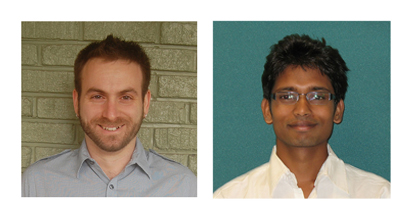Finding the Spin in Quantum Systems
Sometimes the trickiest part of discovery is knowing where to look. UT’s physicists have helped narrow the search for excitations in quantum magnets, furthering the fundamental understanding of spin—a basic property of electrons—in quantum systems. The findings are published in Nature Communications.
The sample for this research was a one dimensional (1D) material comprising strontium, copper, and oxygen (Sr2CuO3), where the Cu atoms form chains in one direction. Assistant Professor and co-author Steve Johnston explained that in a one dimensional material like this the electrons are confined so that they can’t go through one another. Despite these limitations they have strong quantum fluctuations—changes in their properties such as velocity, position, etc. It’s these fluctuations that can cause the electrons to break up, or fractionalize.
“Electrons carry both spin and charge,” Johnston said. “However, in one dimension electron(s) … can ‘break’ into two particle-like excitations: spinons and holons, each carrying the spin and charge quantum numbers. Spinons are particle-like excitations that carry spin but no charge, while holons carry charge but no spin.”
Scientists have refined approaches to model these 1D systems and can create models considerably larger than they can in two dimensions. (In this case that advantage gave them improved momentum resolution and helped them capture the physics they described in the journal.) Yet a key aspect of the 1D realm is that the effects of quantum mechanics are stronger in lower dimensions, making these materials excellent candidates for studying quantum physics.
“The system we're studying is a one dimensional antiferromagnet—one of the best understood 1D quantum systems in the world—but our work showed that this well-known system has new surprises,” Johnston said.
In this kind of system spinons must be created in pairs, so they would show up in multiples of two. Until now, scientists had only directly seen two-spinon excitations.
“The question was where are the four- and six-spinons, etc.,” Johnston said. “Our work showed how you can find them.”
The results were made possible by using a technique called RIXS: resonant inelastic X-ray scattering. When an X-ray beam hits electrons in a material and the beam scatters, scientists can measure its angles, energy, and momentum to learn more about how the x-ray excited the electrons themselves. (Johnston and Assistant Professor Jian Liu recently reported on using RIXS to measure electron-phonon coupling in nanoscale artificial superlattices).
“The significance is that this technique can now be used to look for spinons in other materials, and in particular quantum spin liquids,” Johnston said.
Quantum spin liquids, or QSLs, defy the order of everyday magnets, like the ones on your refrigerator. Those—known as ferromagnets—have atoms lined up in a regular pattern so that their magnetic moments (the spins) are all spinning in the same direction. In a QSL, the spins don’t create such a well-defined order—akin to the molecules in water. Such materials have promise in quantum computing, and given that spinons are the excitations in QSLs, the technique described in Nature Communications could help find them.
While the research is fundamental in nature—exploring quantum systems and the formation of quasi-particles (spinons and holons) —it can also have broader applications for quantum magnetism. As Johnston said, “this can open a lot of doors.”
The work is published in the paper “Probing multi-spinon excitations outside of the two-spinon continuum in the antiferromagnetic spin chain cuprate Sr2CuO3”. Johnston and Physics Graduate Student Umesh Kumar are among the paper’s authors, as well as colleagues from the European X-Ray Free-Electron Laser Facility (Germany), the Paul Scherrer lnstitut, (Switzerland), the Diamond Light Source, Harwell Science and Innovation Campus (United Kingdom), the Indian Institute of Science Education and Research, the Institut de Chimie Moléculaire et des Matériaux d'Orsay, Université Paris-Sud (France), and École Polytechnique Fédérale de Lausanne (Switzerland).

Assistant Professor Steve Johnston and
Graduate Student Umesh Kumar